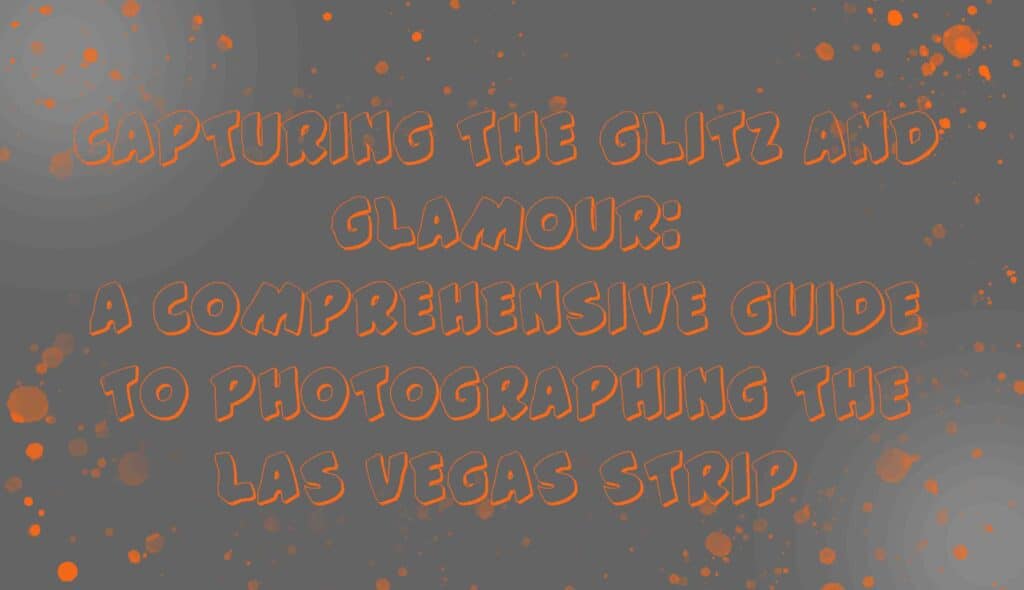Introduction
The Las Vegas Strip is a world-renowned destination known for its dazzling lights, iconic landmarks, and vibrant nightlife. Photographing this iconic stretch of road offers a wealth of opportunities to capture the excitement and energy that define Las Vegas. In this comprehensive guide, we’ll explore the best techniques, equipment, and tips to help you make the most of your photography adventure on the Las Vegas Strip.
1. Planning Your Shoot
a. Timing is Everything
The Las Vegas Strip truly comes alive after dark, when the neon lights and extravagant displays illuminate the city. The period just after sunset, known as the “blue hour,” can be particularly magical as the sky transitions from dusk to night.
b. Scout Locations in Advance
Take some time during the day to scout the locations you want to shoot at night. Familiarize yourself with the best vantage points, angles, and compositions.
2. Gear Essentials
a. Camera
A DSLR or mirrorless camera with manual settings will give you the flexibility to adjust exposure, focus, and other parameters.
b. Lenses
A versatile zoom lens and a fast prime lens are recommended. A wide-angle lens (24-70mm) is excellent for capturing the vastness of the Strip, while a prime lens with a wide aperture (e.g., f/1.8) is ideal for low-light situations.
c. Tripod
A sturdy tripod is essential for long exposures, capturing the city lights, and maintaining sharpness in your images.
d. Remote Shutter Release
A remote shutter release or cable release helps eliminate camera shake during long exposures, ensuring tack-sharp images.
3. Composition Techniques
a. Leading Lines
Utilize the lines of the streets and sidewalks to guide the viewer’s eye through your photograph, creating depth and interest.
b. Reflections
Look for opportunities to capture reflections, especially after rain, to add an extra layer of visual interest.
c. Framing
Use architectural elements like arches or columns to frame your subject and draw attention to the focal point.
4. Handling Low Light Conditions
a. Manual Mode
Switch to manual mode to have full control over your camera settings. Adjust the ISO, shutter speed, and aperture to balance exposure.
b. ISO
In low light, you may need to increase the ISO to maintain a fast enough shutter speed. Be cautious of high ISO settings to minimize noise.
c. Aperture
A wider aperture (lower f-number) allows more light to hit the sensor, which is crucial for shooting in low light conditions.
d. Shutter Speed
Keep your shutter speed fast enough to avoid motion blur, especially if you’re capturing moving subjects.
5. Capturing Iconic Landmarks
a. The Bellagio Fountains
Position yourself at a high vantage point to capture the full spectacle of the fountains in front of the Bellagio Hotel. Use a wide-angle lens to incorporate the surrounding architecture.
b. The Welcome to Fabulous Las Vegas Sign
Visit the sign during the golden hour for soft, warm light. Experiment with different angles and perspectives to capture this iconic symbol.
c. The High Roller Observation Wheel
Shoot from a distance to capture the full wheel, or get closer to focus on its intricate details. Consider shooting at sunset to capture the changing colors of the sky.
6. Experiment with Long Exposures
Long exposures can add a dynamic and surreal element to your Las Vegas Strip photos. Capture the motion of vehicles or people to create a sense of movement against the static backdrop of the city lights.
7. Post-Processing and Editing
Use software like Adobe Lightroom or Photoshop to fine-tune your images. Adjust exposure, contrast, and color balance to bring out the best in your shots.
Conclusion: Immortalizing the Las Vegas Strip
Photographing the Las Vegas Strip is an exhilarating experience that offers endless opportunities for creativity and expression. Armed with the right gear, techniques, and a keen eye for composition, you can capture the glitz, glamour, and excitement of this iconic destination. Remember to experiment, explore, and let your creativity shine through your lens. Happy shooting!
- What is Midjourney
 Discover the capabilities of Midjourney AI, learn how to effectively utilize the platform, and explore the advantages and disadvantages of the Midjourney AI image generator across its different pricing options.
Discover the capabilities of Midjourney AI, learn how to effectively utilize the platform, and explore the advantages and disadvantages of the Midjourney AI image generator across its different pricing options. - Brand identity elements
 In the vast marketing universe, imagery is pivotal in establishing and nurturing a brand’s identity. A brand’s visual choices are not merely aesthetic decisions but strategic moves that can significantly influence perception and performance. This Picfixs article explores the intricacies of selecting imagery that complements and enhances a brand’s essence, ensuring it resonates with the… Read more: Brand identity elements
In the vast marketing universe, imagery is pivotal in establishing and nurturing a brand’s identity. A brand’s visual choices are not merely aesthetic decisions but strategic moves that can significantly influence perception and performance. This Picfixs article explores the intricacies of selecting imagery that complements and enhances a brand’s essence, ensuring it resonates with the… Read more: Brand identity elements - 100 Best Mountain Captions and Mountain Quotes for Instagram
 Ready to scale new social media heights? Look no further than this treasure trove of 100 exhilarating captions and quotes, handpicked for your Instagram mountain posts!
Ready to scale new social media heights? Look no further than this treasure trove of 100 exhilarating captions and quotes, handpicked for your Instagram mountain posts! - Symmetry in Photography: A Creative Approach with Examples
 Delve into the enchanting realm of symmetry in photography as we showcase mesmerizing examples on our website. Experience the allure of perfectly mirrored images!
Delve into the enchanting realm of symmetry in photography as we showcase mesmerizing examples on our website. Experience the allure of perfectly mirrored images! - 11 Quarantine Photoshoot Ideas to Try at Home for Amazing Photos
 Looking for unique photoshoot ideas during quarantine? Explore the 11 creative suggestions that will help you capture unforgettable moments at home.
Looking for unique photoshoot ideas during quarantine? Explore the 11 creative suggestions that will help you capture unforgettable moments at home.


